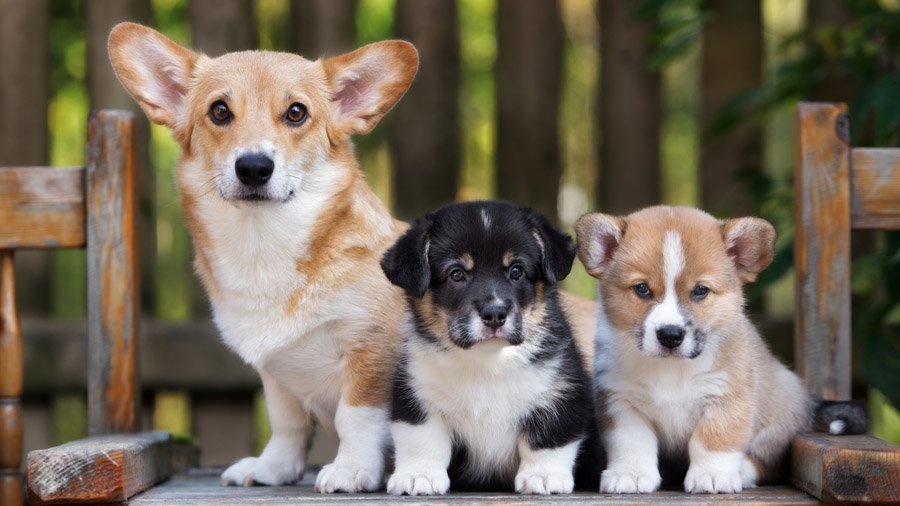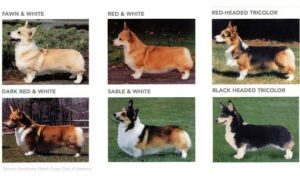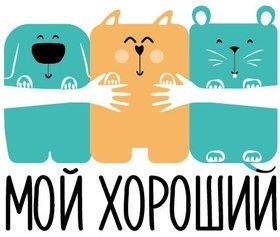
Основная информация
| Название породы: | Вельш-корги |
| Страна происхождения: | Великобритания |
| Время зарождения породы: | 3000 лет назад |
| Тип: | пастушьи и скотогонные |
| Вес: | 12 – 15 кг |
| Рост (высота в холке): | 25 – 30 см |
| Продолжительность жизни: | 12 – 15 лет |
|
Классификация МКФ:
|
Группа 1, Секция 1, Номер 38-39 |
| Цена щенков: | 900 – 2100 $ |
| Самые популярные клички: | список кличек для вельш-корги |
Оценка характеристик породы
|
Адаптивность (определение, означающее, насколько легко собака может приспосабливаться к изменениям в жизни) |
🐶🐶🐶🐶🐶 |
|
Уровень линьки (Уровень и частота выпадения волос у животного) |
🐶🐶🐶🐶🐶 |
|
Уровень нежности (Уровень и количество нежности и ласки, которую собака отдает взамен на внимание к себе) |
🐶🐶🐶🐶🐶 |
|
Потребности в упражнениях (Уровень дневной активности собаки) |
🐶🐶🐶🐶 |
|
Социальная потребность (Необходимое количество контактов собаки с другими животными, а также людьми) |
🐶🐶🐶 |
|
Квартирное содержание (Фактор, определяющий уровень шума и иных неудобств, которые собака может доставлять хозяевам в соотношении размера квартиры к размеру собаки) |
🐶🐶🐶🐶🐶 |
|
Груминг (Количество купаний, расчесываний, а также необходимое количество сеансов профессионального груминга, необходимого собаке) |
🐶🐶🐶 |
|
Дружелюбность в незнакомой среде (Особенности поведения собаки в обществе с незнакомыми людьми или в незнакомой обстановке) |
🐶🐶🐶 |
|
Тенденция к лаю (Склонность к лаю и его частоте и громкости) |
🐶🐶🐶 |
|
Вопросы здоровья (Потенциальный уровень состояния здоровья собаки) |
🐶🐶 |
|
Территориальность (Склонность собаки к защите своего дома, двора или даже автомобиля хозяина) |
🐶🐶🐶 |
|
Дружелюбность к котам (Тенденция к терпимости к кошкам и пониженное проявление охотничьих инстинктов) |
🐶🐶🐶🐶🐶 |
|
Интеллект (Способность собаки к мышлению и решению возникающих трудностей (не стоит путать с обучаемостью!) |
🐶🐶🐶🐶🐶 |
|
Воспитание и дрессировка (Уровень сложности в обучении собаки выполнять определенные действия) |
🐶🐶🐶🐶🐶 |
|
Дружелюбность к детям (Фактор, определяющий насколько собака дружелюбна к детям, любит ли она с ними играть и терпеть некоторые детские шалости) |
🐶🐶🐶🐶🐶 |
| Игровая активность
(Понятие определяется самим его названием, и, как правило, встречается почти у всех собак) |
🐶🐶🐶🐶 |
|
Наблюдательность (Способность собаки определить присутствие чужого на своей территории) |
🐶🐶🐶🐶🐶 |
|
Дружелюбность к другим собакам (Склонность собаки находить общий язык с другими своими сородичами) |
🐶🐶🐶 |
Краткое описание породы
Вельш-корги – это невысокая собачка с удлиненным телом и прямостоячими большими ушами. По своей внешности представители этой породы весьма похожи на лису. Этот образ удачно подчеркивают круглые темные глаза с характерным черным ободком. У пемброков ноги прямые, чего нельзя сказать о кардиганах. Как правило, хвосты у этих собак купируют, даже в тех случаях, когда они сравнительно коротки от рождения, ведь необходимо соблюдать стандарт породы.
Вельш-корги пемброк появился примерно в двенадцатом веке. Это делает его более молодым в сравнении с непосредственным сородичем – вельш-корги кардиган. Некоторые исследователи истории собак предполагают, что название породы происходит от валлийского слова «корг» – карликовый. Густая и мягкая шерсть может иметь рыжий, соболиный, палевый или черно-подпалый окрас с характерными для этой породы белыми отметинами. В идеале рост вельш-корги должен составлять порядка 25-30 сантиметров в холке, а вес может варьироваться от 12 до 15 килограммов.
Шерсть у вельш-корги средней длины и имеет пуховый подшерсток. Длина шерсти и ее внешний вид могут несколько отличаться. К примеру, некоторые представители породы имеют пушистую опушку на ушах, у других на шее присутствует оригинальный ерш. Одни вельш-корги обладают волнистой шерстью, а другие – прямой. Но все это не влияет на характер и общие характеристики собаки. Отличительная черта пемброков – отметина на спине в виде седла, которую часто называют «седлом феи».
Фото вельш-корги:

История происхождения
Вельш-корги имеет достаточно богатую историю. Его предки были завезены в Англию с материка в 1107-м году фламандскими ткачами, которые, в конечном итоге, поселились в юго-западной части Уэльса. Порода имеет общие корни с кеесхондами и чау-чау, финским и померанским шпицем, а также с норвежским элкхаундом, которых изначально разводили для помощи пастухам при выпасе овец и крупного рогатого скота. Из-за особенностей телосложения корги очень ценились среди пастухов. Также эти собаки помогали перегонять большие стаи гусей на рынок. Со временем они так полюбились пастухам, что заняли достойное место домашнего любимца и настоящего члена семьи.
Сходство пемброка и вельш-корги кардигана неслучайна. Обе породы были скрещены в начале девятнадцатого века, когда щенки кардигана были проданы фермерам региона Пембрукшир и Кармартеншир. Массовое скрещивание этих пород началось в начале двадцатого века. Современные же селекционеры не допускают кровосмешения двух пород собак, сохраняя отдельную родословную пемброка и кардигана.
Английский клуб любителей вельш-корги был создан в 1925-м году. Вельш-корги пемброк и вельш-корги кардиган были признаны самостоятельной породой английским Кеннел-клубом в 1934-м году. Королева Елизавета II относилась к этой породе с особым трепетом, несмотря на то, что пастушьи собаки принесли немало хлопот Букингемскому дворцу. Именно особое отношение королевского двора к пемброку позволила популярности этой породы взлететь особенно высоко в сравнении с кардиганом.
Американский клуб собаководства признал вельш-корги в 1934-м году и отнес его в группу пастушьих собак. Через два года в США появился первый клуб любителей этой породы. Сегодня вельш-корги является собакой, которая проявляет особые способности в аджилити, выполнении команд, она стала настоящим другом для тысяч семей.
Характер вельш-корги
Вельш-корги хотя и является сравнительно небольшой собачкой, но у нее очень широкая и добрая душа. Их характер и поведение сложился главным образом на основе того, что в течение долгого времени предки этой породы занимались выпасом скота, вели активный образ жизни, находились постоянно в движении.
Сегодня корги все еще весьма популярны на различных фермах, ну а особой популярностью пользуются среди активных семей. Это и понятно, пассивным людям, с ограниченным свободным временем корги, конечно же, не подойдет. Эти собаки отлично ладят с другими домашними животными. Они непревзойденно справляются с задачами сторожевых собак.
Вельш-корги – это собаки с собственным «я», они имеют свое мнение и хотят, чтобы с ним считались. Но главное их желание – радовать людей, особенно близких. Наблюдая за поведением корги, можно заметить, как эти удивительные собачки меняют свое поведение: от шутовского до безумно серьезного.
Несмотря на высочайший уровень активности вельш-корги, им совсем не обязательно выполнять огромное количество физических упражнений. Для поддержания здоровья и хорошего настроения будет достаточно совсем небольшого количества активных прогулок, игр или других упражнений.
Представители этой породы прекрасно адаптируются к различным условиям проживания. Они отлично себя чувствуют на фермах, в частных домах с собственным двором, в квартире или даже в общежитии. Главное – чтобы ваш питомец не мешал окружающим. Но необходимо понимать, что вне зависимости от места проживания, собаку ежедневно необходимо выгуливать на свежем воздухе, играть с ней, а в парк выходить минимум один раз в неделю.
Мы упоминали, что корги могут замечательно обходиться и без активных физических упражнений, но об активной умственной стимуляции этого сказать нельзя. Владельцы корги должны обеспечить домашнего любимца достаточным количеством логических, интерактивных игр. В противном случае характер питомца может резко испортиться, от чего будут страдать как окружающие люди, так и мебель, а также предметы быта.
Содержание и уход
За вельш-корги очень просто ухаживать. Их не очень длинная шерсть требует всего лишь еженедельного вычесывания. Этого вполне достаточно для удаления отмерших волосков. Фазы активной линьки у вельш-корги наступают дважды в год. В этот период, конечно же, расчесывать питомца необходимо намного чаще. Пемброки относятся к очень чистоплотным собакам, поэтому большинство владельцев купают их примерно раз в два-три месяца.
Необходимо регулярно проверять состояние ушей корги на наличие признаков загрязнения, раздражения или инфекций. Очищать их необходимо специальным раствором по назначению ветеринара. Ни в коем случае не стоит использовать для прочистки слухового канала ватный тампон!
Полость рта также предполагает еженедельный уход. Главным образом требуется чистка зубов. Процедура поможет исключить стоматологические заболевания, в том числе и образование зубного камня, а также возникновение характерного неприятного запаха изо рта. Если питомец не стачивает когти естественным образом, то их необходимо подстригать самостоятельно. Обычно делают это раз в месяц.
Дрессировка и обучение
Вельш-корги обладают волевым характером. Они привыкли получать то, чего хотят. Поэтому в процессе обучения вам понадобится немало терпения и выдержки. Главным помощником в дрессировке станут вознаграждения в виде лакомств и, конечно же, в виде похвалы. Обратите внимание, что дрессируя собаку, нужно напрочь забыть о грубости и агрессии, которые будут иметь негативный эффект. Животное должно получать от занятий удовольствие, поэтому лучше проводить короткие, но более частые занятия, которые не будут надоедать домашнему любимцу.
Тренировка собак этой породы предполагает определенную системность. Необходимо переходить от простого к сложному. После освоения базовых команд и заданий смело переходите к обучению отслеживанию и аджилити. Необходимо дать возможность питомцу развиваться и направлять всю его энергию в полезное русло.
Вельш-корги – отличные сторожа. Они своевременно будут бить тревогу при виде незваных гостей, но такое поведение необходимо держать под контролем посредством ранних тренировок. Именно поэтому важное место в жизни собак этой породы занимает этап социализации. Вельш-корги недоверчив к незнакомцам, ваша задача – научить питомца отличать чужака от своего. В противном случае собака будет часто лаять, что не совсем понравится вашим соседям, а что уж говорить в случае, когда вы проживаете в общежитии…
В то время, как большинство собак проявляют особую теплоту к детям, корги может проявлять доминирование, особенно если речь идет о группе детей. Собака их будет воспринимать как объект для выпаса, все это сформировано на генетическом уровне. Именно с этим связано требование опытных селекционеров о нецелесообразности игр корги с детьми без присмотра взрослых.
Здоровье и болезни вельш-корги
Несколько интересных фактов
- Вельш-корги считается одной из самых древних собак.
- Несмотря на свой небольшой рост, эти собаки отлично справляются с различными активными заданиями.
- Корги хорошо поддается дрессировке, при условии, что она начата с раннего возраста.
- Для собак этой породы обязателен процесс ранней социализации.
- Вельш-корги сможет проживать в любых домах, вне зависимости от размера.
- Ухаживать за питомцем этой породы очень просто.
- Корги лучше не приобретать семьям, в которых много детей.
Питомники и заводчики
Материал мы заимствовали с замечательного сайта наших партнеров DOGCATFAN.COM о кошках и собаках, автор dogcatfan
Интересные профили:
Посмотреть эту публикацию в Instagram
Посмотреть эту публикацию в Instagram
Посмотреть эту публикацию в Instagram
